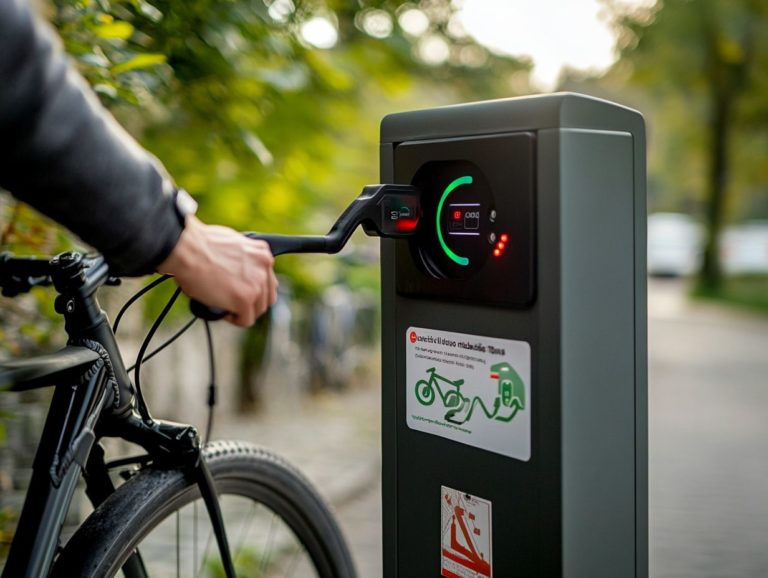How Often Should I Replace My E-Bike Battery?
e-bike batteries serve as the heart of your electric ride, impacting everything from range to performance.
It s crucial for you to grasp the various types of batteries, the factors that influence their battery life, and the telltale signs that suggest it s time for a replacement.
Get ready to supercharge your e-bike experience with this essential guide! This guide will help you maintain your battery effectively, identify when it needs replacing, and choose a new e-bike battery that aligns with your specific needs and budget.
Prepare to elevate your e-biking experience to new heights, whether you’re in Darmstadt or Indiana!
Contents
- Key Takeaways:
- Understanding E-Bike Batteries
- Signs that Your E-Bike Battery Needs Replacing
- How to Properly Maintain Your E-Bike Battery
- When to Replace Your E-Bike Battery
- Factors to Consider When Choosing a New E-Bike Battery
- Frequently Asked Questions
- How Often Should I Replace My E-Bike Battery?
- What Factors Affect the Lifespan of an E-Bike Battery?
- Can I Extend the Lifespan of My E-Bike Battery?
- When Should I Start Considering Replacing My E-Bike Battery?
- What Are the Signs That My E-Bike Battery Needs to Be Replaced?
- Is It Possible to Replace the Battery on My Own?
Key Takeaways:
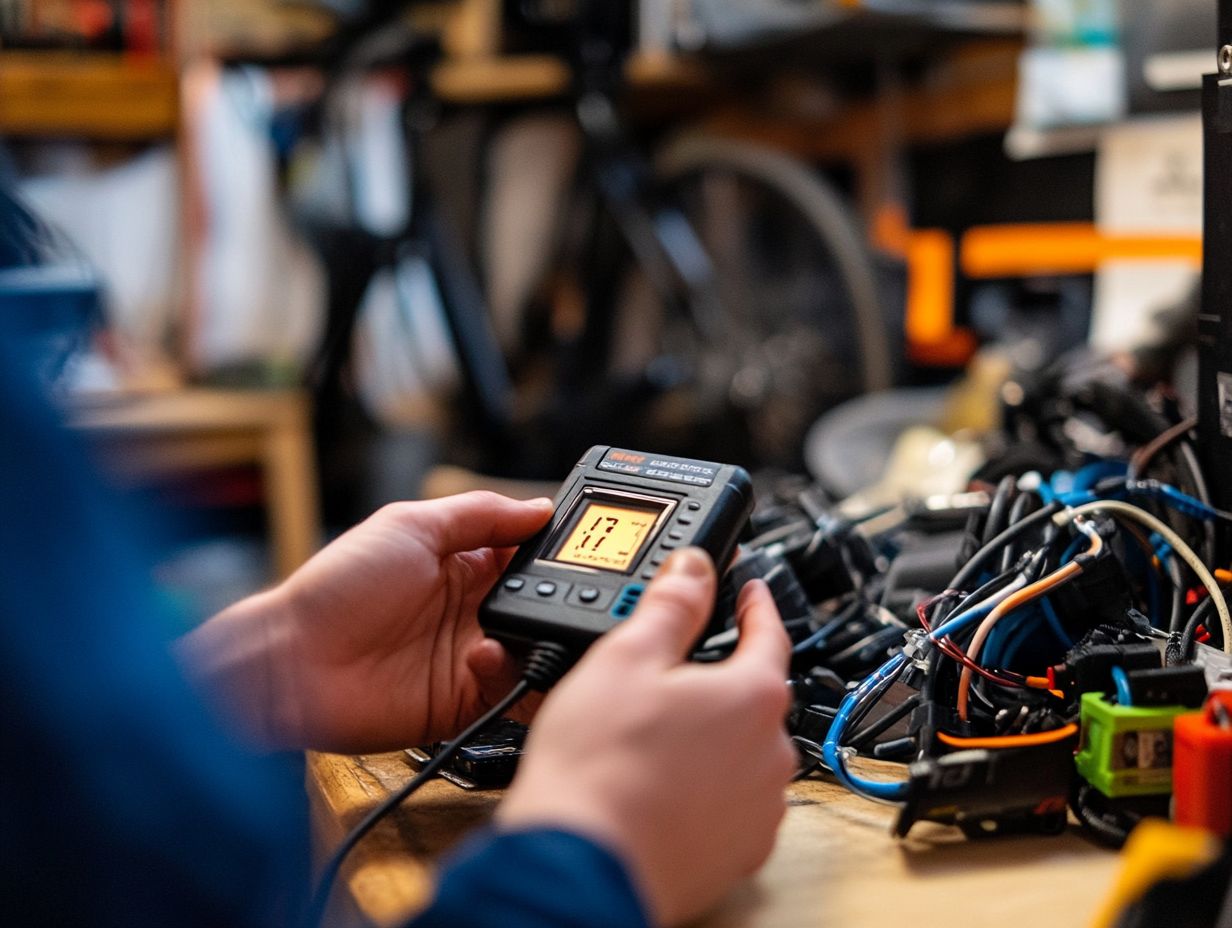
- Regular maintenance extends battery life! Observe how you charge your battery and avoid overcharging.
- Watch for signs of wear. A drop in range or visible damage indicates it s replacement time!
- Consider battery capacity, compatibility, budget, reliability, and environmental factors when choosing a new e-bike battery.
Understanding E-Bike Batteries
Understanding e-bike batteries is essential for you as an e-bike owner since these batteries serve as the heart of your e-bike system, influencing performance, longevity, and your overall experience.
Thanks to advancements in battery technology, especially with lithium batteries, you can enjoy benefits like extended battery life and efficient charge cycles crucial for e-bike owners. However, be mindful that factors such as temperature control, environmental conditions, and how you charge your battery can greatly affect the performance and lifespan of your e-bike battery, particularly in winter and summer.
In this section, you will discover the different types of e-bike batteries, learn about their maintenance, and uncover the best practices for ensuring optimal battery performance, including important maintenance tips.
Types of E-Bike Batteries
There are primarily two types of batteries you’ll encounter in e-bikes: lithium batteries and lead-acid batteries. Each brings its own mix of advantages and drawbacks, including variations in charge cycle lifespan.
Lithium batteries truly shine with their lightweight design, greatly enhancing your e-bike’s overall efficiency. Their impressive energy density how much power a battery can store in a given space allows them to store more power in a smaller package. This is especially true when compared to the bulkier, heavier lead-acid options.
You’ll appreciate that lithium batteries can handle far more charge cycles, often exceeding a thousand before showing significant wear, while lead-acid typically caps out around 500 cycles, contributing to their extended lifespan. Though the initial investment in lithium batteries is generally higher, brands like ESKUTE, LG, and Sony are well-known for their superior quality and long-lasting performance.
These brands are endorsed by organizations like PeopleForBikes and Call2Recycle, making them a wise choice for e-bike enthusiasts like yourself.
Factors Affecting Battery Life
Several factors can have a substantial impact on the battery life of your e-bike. These include environmental conditions, how you charge your battery, and the number of charge cycles it undergoes.
Temperature fluctuations, whether scorching heat in summer or bitter cold in winter, are crucial in determining your battery’s performance over time. In high temperatures, the batteries may encounter accelerated chemical reactions that reduce their effectiveness. Extreme cold can hinder the electrochemical processes necessary for optimal energy output, emphasizing the importance of temperature control.
To navigate these challenges effectively, it s vital to adopt proper charging habits to prevent overcharging and extend battery life. Resist the urge to overcharge, as this not only prevents overheating but also significantly extends the battery’s lifespan, mitigating risks associated with performance decline.
Charge your battery in a temperature-controlled environment to safeguard against moisture and swelling. This ensures you get the most out of your e-bike experience!
Signs that Your E-Bike Battery Needs Replacing
As an eBike owner, it’s crucial to recognize the signs that your eBike battery may need replacing. This awareness helps maintain optimal performance and ensures your safety during rides, especially by watching for signs of failure like swelling or physical damage.
Look out for common warning signs like less power, a reduced range per charge, and a noticeable decline in performance while riding, indicating it might be time to replace the battery. To ensure longevity, it’s crucial to know how to care for your e-bike battery. Over time, batteries can exhibit physical symptoms, such as swelling and physical damage, which are important signs to watch for.
By understanding these indicators, you can make informed decisions about when to replace your eBike battery, ultimately enhancing your riding experience and ensuring a safer ride. For more details, check out what is the lifespan of an e-bike battery?
Decreased Range and Performance
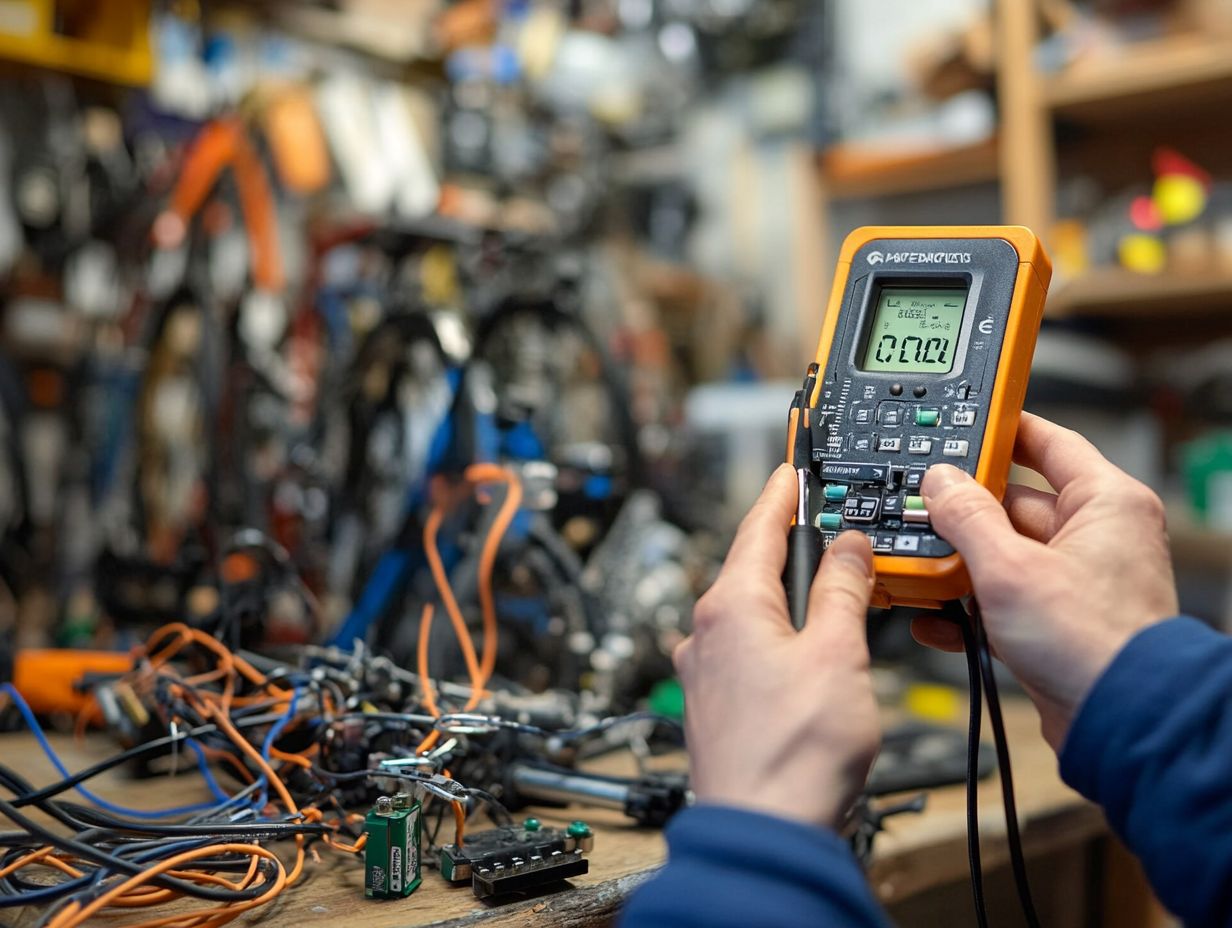
A key indicator that your eBike battery might need replacing is a noticeable drop in range and performance, often accompanied by a frustrating decrease in power during your rides, signaling the need for intervention.
To monitor the battery s performance over time, you have several effective methods at your disposal, including tracking charge cycles and utilizing performance apps. One powerful approach is to track charge cycles, which means keeping tabs on the process of depleting and recharging the battery, thus understanding its charge cycle lifespan. By maintaining a log of these cycles, you can start to identify patterns of degradation, giving you a heads-up on when the battery’s efficiency starts to take a hit and might need a replacement.
Using apps or software that monitor the battery’s voltage and health provides valuable insights into its overall performance and helps you avoid signs of failure. Regularly checking the range your eBike can cover on a full charge also gives you practical evidence of any deterioration, allowing you to gauge precisely when it might be time for a replacement to maintain optimal battery performance. Additionally, understanding how often to service your electric bicycle can further enhance performance and longevity.
Physical Wear and Tear
Physical wear and tear can show up in several ways, signaling that your eBike battery might be nearing the end of its usable life, including visible signs of swelling and corrosion.
One prominent sign to watch for is swelling; if your battery looks puffed up or unevenly shaped, it s a clear indicator that it s struggling and could pose safety risks, necessitating immediate attention. Corrosion, often appearing as a white or greenish residue around the terminals, can hinder electrical connections and significantly affect battery performance. If you notice visible cracks on the casing, those could expose internal components to moisture and dust, leading to further degradation, which clearly indicates potential failure.
Each of these symptoms not only points to declining functionality, but they also serve as a crucial reminder that acting quickly is essential to ensure safety and reliability in your eBike experience, particularly before embarking on long rides.
How to Properly Maintain Your E-Bike Battery
Maintaining your eBike battery is essential for ensuring its longevity and optimal performance, particularly when it comes to lithium batteries that demand specific care to avoid overcharging risks. By focusing on proper maintenance, you can significantly extend your battery’s lifespan, maximizing charge cycles and minimizing the risk of performance decline, ensuring a safer eBike riding experience.
Key practices include maintaining proper charging guidelines and ensuring you store the battery correctly.
- Following recommended charging guidelines to avoid overcharging,
- Storing the battery correctly in a temperature-controlled environment,
- Regularly inspecting for any signs of potential issues, especially swelling and corrosion.
By implementing these maintenance tips, you can enjoy a more reliable riding experience while decreasing the chances of unexpected battery replacements to maintain optimal performance.
Tips for Extending Battery Life
Extending the life of your eBike battery involves adopting specific practices that enhance its performance while minimizing the impact of environmental factors like temperature and moisture.
First and foremost, understand optimal charging habits to avoid risks associated with overcharging. Never let your battery drop to a complete zero before recharging, as this can strain its capacity and lead to performance decline. Ideally, aim to charge it when it reaches around 20%-30%. This simple practice helps maintain efficiency and prolongs the charge cycle lifespan.
Temperature control is another crucial factor for maintaining battery performance and longevity. Storing your battery in a cool, dry place prevents overheating, which can degrade its performance and lead to potential safety risks. Regular maintenance checks are equally important. Inspect for corrosion and ensure connections are clean to bolster longevity.
By implementing these thoughtful strategies, you can significantly prolong the lifespan of your eBike battery, ensuring countless rides ahead without unexpected battery failures.
When to Replace Your E-Bike Battery
Knowing when to replace your eBike battery keeps your rides smooth and enjoyable! Typically, eBike batteries can last anywhere from two to five years, depending on how often you use it and the care you provide.
If you notice signs like a sudden drop in performance or an inability to hold a charge, it might be time to consider a replacement sooner than expected to maintain safety.
This knowledge helps you make smart choices about your eBike battery, enhancing your overall riding experience.
Recommended Replacement Timeframe
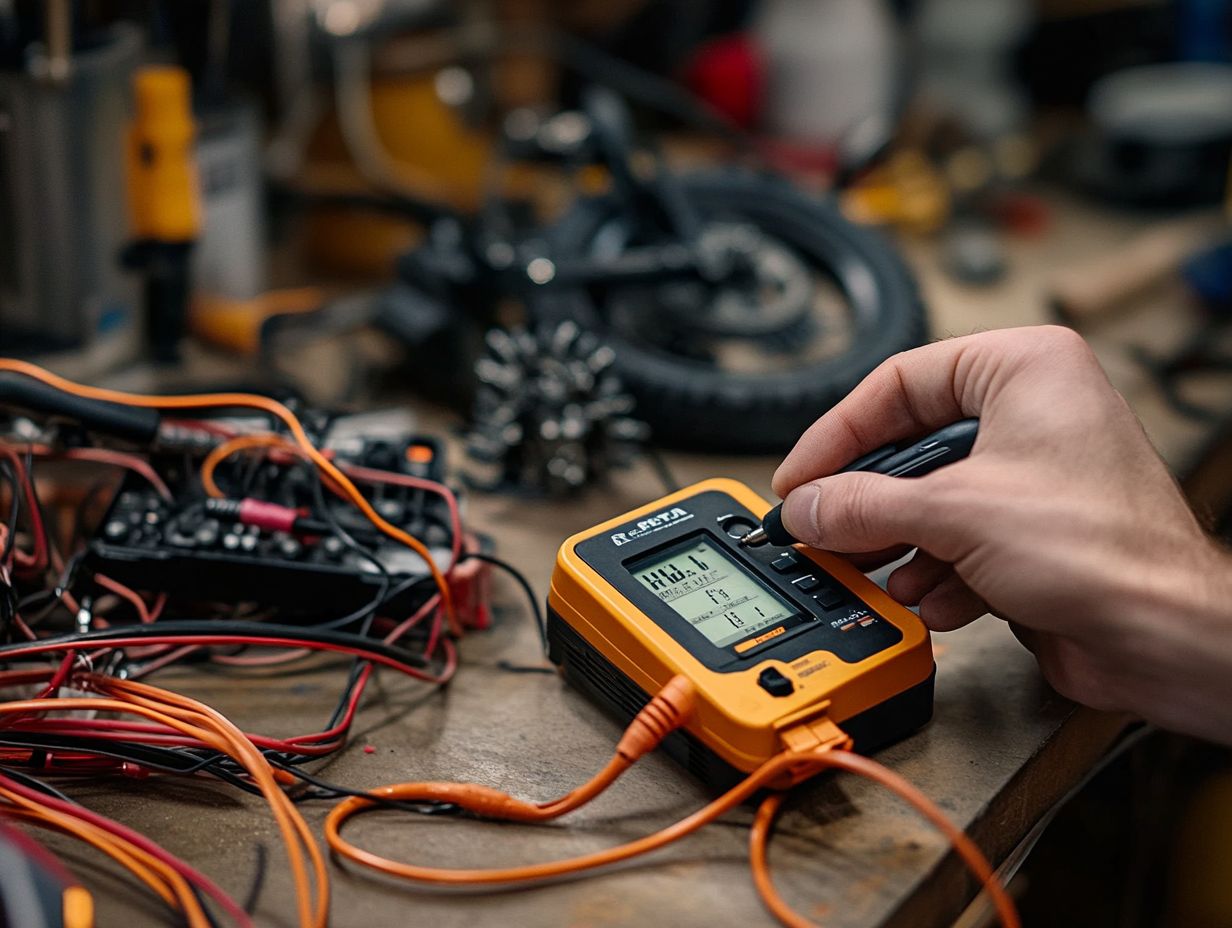
The recommended replacement timeframe for eBike batteries typically ranges from two to five years, influenced by factors like usage, battery type, charge cycles, and maintenance.
To effectively gauge the performance of your eBike batteries, it’s essential to regularly monitor charge cycles and pay attention to any noticeable declines in range or power output. Keeping track of how often you charge the battery and its condition over time can offer valuable insights into its longevity and help you detect early signs of failure. If you’re curious about the lifespan of your eBike, check out what is the average lifespan of an e-bike.
Don t overlook external factors such as temperature and storage conditions. Extreme environments can significantly affect battery health, especially during winter and summer. By being mindful of these details, you can make informed decisions about when to replace your battery, ensuring that you continue to enjoy optimal performance from your rides.
Factors to Consider When Choosing a New E-Bike Battery
When selecting a new eBike battery, it s vital to consider several key factors that will significantly impact your riding experience. You’ll want to pay close attention to battery capacity, ensure compatibility with your specific eBike model, and keep your budget in mind. Choosing a battery that aligns with your bike’s specifications and performance expectations is essential.
Brand reliability is another critical aspect, as it guarantees you re investing in a quality product that meets your needs. Opting for reputable manufacturers like LG and Sony can make all the difference.
By understanding these factors, you ll enable yourself to make informed decisions when it comes to selecting your new eBike battery, enhancing both your ride and your overall satisfaction. Check the signs of battery decline regularly to keep your rides uninterrupted!
Battery Capacity and Compatibility
When selecting a new eBike battery, it s important to understand battery capacity and ensure compatibility with your existing eBike model. This is key to achieving optimal performance.
Start by checking the watt-hour (Wh) rating of the battery. This figure indicates how much energy the battery can store and provide over time. Also, consider the type of lithium battery, as different chemistries can significantly impact performance and longevity.
Scrutinize your eBike’s specifications. Confirm that the new battery’s voltage and physical dimensions align with your bike’s requirements. Also, evaluate the connector types and overall build quality to make an informed decision that enhances both safety and efficiency on the road. Additionally, consider understanding e-bike battery lifespan for long-term performance.
Budget and Brand Reliability
Budget considerations and brand reliability are important when selecting a new eBike battery, influencing both immediate costs and long-term performance.
As you evaluate your options, balance the upfront expenses against the battery’s durability and efficiency over time. Investing in reputable brands can greatly enhance your overall eBike experience. For example, well-known manufacturers like LG and Sony are famous for their exceptional lithium batteries, which promise an impressive lifespan and reduce the likelihood of early replacements. Additionally, it’s important to know when to replace your electric bicycle battery to ensure optimal performance.
If you’re looking to balance performance needs and budget constraints, prioritize these trusted brands. This will ensure your eBike provides optimal power while keeping maintenance costs down.
Frequently Asked Questions
How Often Should I Replace My E-Bike Battery?
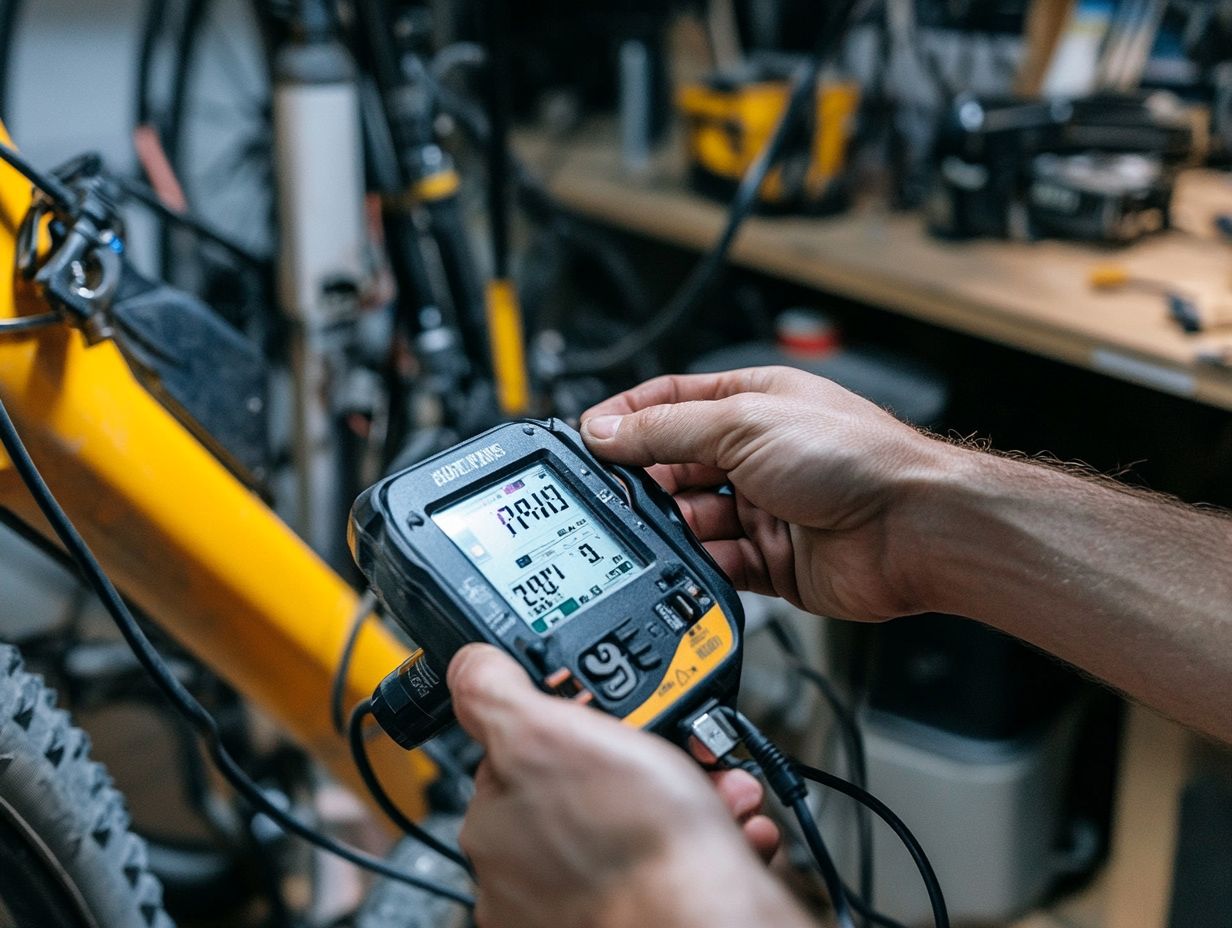
The frequency of replacing your e-bike battery depends on several factors, such as usage, storage, and battery type. On average, e-bike batteries last between 2-5 years.
What Factors Affect the Lifespan of an E-Bike Battery?
The main factors affecting the lifespan of an e-bike battery include usage, storage, and quality. Frequent use, extreme temperatures, and leaving the battery uncharged for long periods can all shorten its lifespan.
Can I Extend the Lifespan of My E-Bike Battery?
Yes! You can extend the lifespan of your e-bike battery by taking proper care of it. This includes avoiding extreme temperatures, charging it regularly, and storing it in a cool, dry place.
When Should I Start Considering Replacing My E-Bike Battery?
If you notice a significant decrease in your e-bike’s range or if it fails to hold a charge, it may be time to consider replacing your battery. It’s also recommended to replace your battery after 2-3 years of use.
What Are the Signs That My E-Bike Battery Needs to Be Replaced?
Common signs that your e-bike battery needs replacing include a decrease in power or range, difficulty holding a charge, and physical damage or corrosion on the battery itself.
Is It Possible to Replace the Battery on My Own?
You can replace your e-bike battery on your own, but we recommend seeking professional assistance. This ensures proper installation and compatibility with your e-bike model, helping you avoid safety hazards or damage.
Explore your options today!





